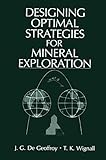Designing optimal strategies for mineral exploration Libro electrónico J. G. De Geoffroy, T. K. Wignall
Tipo de material: Libro
en línea Idioma: Inglés Detalles de publicación: New York, New York, United States Plenum Press c1985Descripción: xv, 364 páginas 24 centímetrosISBN:
Libro
en línea Idioma: Inglés Detalles de publicación: New York, New York, United States Plenum Press c1985Descripción: xv, 364 páginas 24 centímetrosISBN: - 0306419777
- 9781468412321 (Print)
- 9781468412307 (Online)
- Disponible en línea
Incluye bibliografía e índice: páginas 355-359
1. Optimizing mineral exploration.. 2. Evaluation of the probability of detection of mineral deposits.. 3. Cost of detection.. 4. Optimizing ore detection.. 5. Application of the optimization methodology to the search for six types of ore deposits in north America.. 6. Designing optimized field programs for the detection of porphyry-cu-mo deposits of the north American cordillera belt.. 7. Optimized search for four types of contact metasomatic deposits of the north American cordillera belt.. 8. Detection of NI-CU ultramafic deposits of the north American shield by optimized geophysical surveys and drilling programs.. 9. Optimized airborne and ground search for volcanogenic massive sulfide deposits of the north American shield and cordillera belt.. 10. Designing optimized field programs for the detection of Mississippi valley-type PB-ZN deposits of the north American arctic Paleozoic platform.. 11. Detection of vein-gold deposits of the north American shield by optimized ground programs.. 12. Optimal selection of exploration targets for drill testing.. 13. Conclusion.. Subject Index
Disponible para usuarios de ECOSUR con su clave de acceso
Few knowledgeable people would deny that the field of mineral exploration is facing some difficult times in the foreseeable future. Among the woes, we can cite a worldwide economic uneasiness reflected by sluggish and at times widely fluctuating metal prices, global financial uncertainties, and relentless pressures on costs despite a substantial slowing down of the rate of inflation. Furthermore, management is forced to tum to more sophisticated and expensive technologies and to look farther afield to more remote regions, as the better quality and more easily accessible ore deposits have now been revealed. This rather gloomy outlook should persuade explorationists to cast about for a new philosophy with which to guide mineral exploration through the challenging decades ahead. Once already, in the early 1960s, a call for change had been heard (Ref. 30 in Chapter 1), when it became obvious that the prospecting methods of yesteryear, so successful in the past, could not keep up with the rapidly growing demand for minerals of the postwar period. The answer, a massive introduction of sophisticated geophysical and geochemical technologies backed by new geo logical models, proved spectacularly successful throughout the 1960s and the 1970s. But for both economic and technological reasons, the brisk pace of the last two decades has considerably slowed down in the early 1980s, as if a new threshold has been reached. Inglés
Disponible en línea
Disponible en formato PDF


